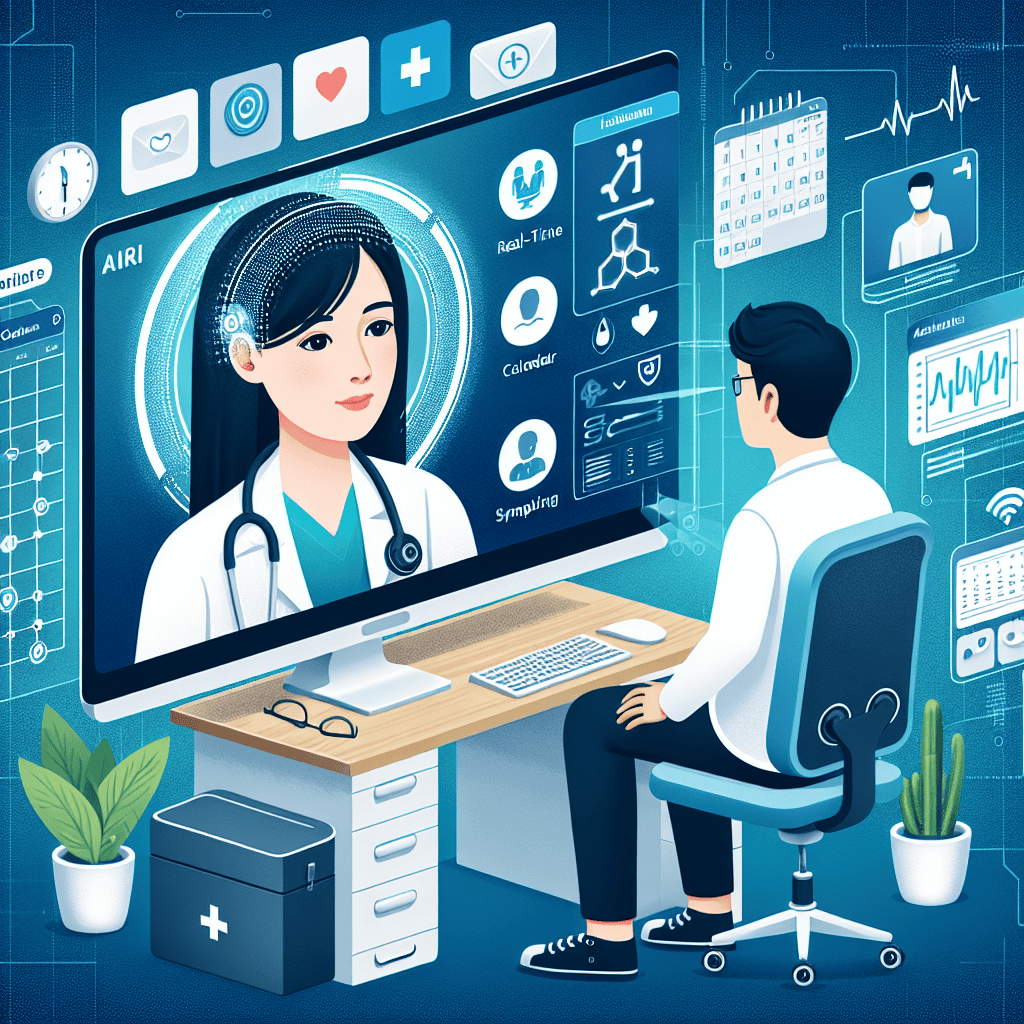Zoom Unveils Next-Gen AI Features for Healthcare Providers

In an era where digital transformation is reshaping industries, healthcare is no exception. The integration of technology into healthcare practices has been accelerated by the global pandemic, and companies like Zoom are at the forefront of this evolution. Zoom, a leader in video conferencing solutions, has recently unveiled its next-generation AI features specifically designed for healthcare providers. These innovations promise to revolutionize patient care, streamline operations, and enhance the overall healthcare experience. This article delves into the details of these AI features, exploring their potential impact on the healthcare industry.
1. Enhancing Patient-Provider Communication
Effective communication between patients and healthcare providers is crucial for accurate diagnosis and treatment. Zoom’s new AI features aim to bridge communication gaps and facilitate seamless interactions.
1.1 Real-Time Language Translation
One of the standout features of Zoom’s AI capabilities is real-time language translation. In a multicultural world, language barriers can hinder effective communication between patients and healthcare providers. Zoom’s AI-driven translation tool can translate spoken language in real-time, allowing providers to communicate with patients in their native language. This feature is particularly beneficial in diverse urban areas where multiple languages are spoken.
For instance, a study conducted by the Migration Policy Institute found that over 25 million people in the United States have limited English proficiency. By integrating real-time translation, healthcare providers can ensure that these patients receive accurate information and feel more comfortable during consultations. This not only improves patient satisfaction but also reduces the risk of miscommunication-related errors.
1.2 Sentiment Analysis for Better Understanding
Zoom’s AI also includes sentiment analysis, which can assess the emotional tone of a conversation. This feature helps healthcare providers gauge a patient’s emotional state, providing insights that may not be immediately apparent through words alone. By understanding a patient’s emotions, providers can tailor their approach, offering empathy and support where needed.
For example, a patient discussing a chronic illness may express frustration or anxiety. Sentiment analysis can alert the provider to these emotions, prompting them to address the patient’s concerns more effectively. This level of understanding can lead to improved patient-provider relationships and better health outcomes.
1.3 Automated Transcription Services
Accurate documentation is a cornerstone of effective healthcare delivery. Zoom’s AI-powered transcription services automatically transcribe conversations between patients and providers, ensuring that no detail is missed. These transcriptions can be integrated into electronic health records (EHRs), streamlining the documentation process and reducing administrative burdens on healthcare professionals.
According to a report by the American Medical Association, physicians spend nearly two hours on administrative tasks for every hour of patient care. By automating transcription, Zoom’s AI features free up valuable time for providers, allowing them to focus more on patient care rather than paperwork.
2. Streamlining Telehealth Services
Telehealth has become an integral part of modern healthcare, offering convenience and accessibility to patients. Zoom’s AI features are set to enhance telehealth services, making them more efficient and effective.
2.1 Virtual Health Assistants
Zoom’s AI includes virtual health assistants that can assist patients before, during, and after telehealth appointments. These assistants can guide patients through the process of setting up appointments, provide reminders, and answer frequently asked questions. By automating these tasks, healthcare providers can focus on delivering care rather than administrative duties.
For example, a virtual health assistant can remind a patient to take their medication or prepare for an upcoming appointment. This level of support ensures that patients are well-prepared and engaged in their healthcare journey, leading to better adherence to treatment plans and improved health outcomes.
2.2 AI-Driven Diagnostics
Zoom’s AI capabilities extend to diagnostics, where machine learning algorithms can analyze patient data to assist in diagnosis. By leveraging vast amounts of medical data, these algorithms can identify patterns and suggest potential diagnoses, aiding healthcare providers in making informed decisions.
A study published in the Journal of the American Medical Association found that AI-driven diagnostic tools can improve accuracy and speed in identifying conditions such as diabetic retinopathy and skin cancer. By integrating these tools into telehealth services, Zoom enables providers to offer high-quality care remotely, expanding access to specialized services for patients in underserved areas.
2.3 Secure Data Management
Data security is a top priority in healthcare, and Zoom’s AI features include robust security measures to protect patient information. End-to-end encryption ensures that all communications and data exchanges are secure, maintaining patient confidentiality and compliance with regulations such as HIPAA.
In a survey conducted by the Healthcare Information and Management Systems Society, 75% of healthcare organizations reported experiencing a significant security incident in the past year. By prioritizing data security, Zoom’s AI features provide peace of mind to both providers and patients, fostering trust in telehealth services.
3. Improving Clinical Decision-Making
Clinical decision-making is a complex process that requires careful consideration of various factors. Zoom’s AI features offer tools to support healthcare providers in making informed decisions.
3.1 Predictive Analytics for Patient Outcomes
Zoom’s AI leverages predictive analytics to assess patient data and predict potential health outcomes. By analyzing historical data and identifying trends, these tools can help providers anticipate complications and intervene proactively.
For instance, predictive analytics can identify patients at risk of readmission after discharge, allowing providers to implement targeted interventions to prevent readmission. A study published in the New England Journal of Medicine found that predictive analytics reduced hospital readmissions by 20%, highlighting the potential of these tools to improve patient outcomes and reduce healthcare costs.
3.2 Decision Support Systems
Zoom’s AI includes decision support systems that provide evidence-based recommendations to healthcare providers. These systems analyze patient data and offer suggestions for treatment plans, ensuring that providers have access to the latest medical knowledge and guidelines.
For example, a decision support system can recommend appropriate medication dosages based on a patient’s age, weight, and medical history. By providing real-time guidance, these systems enhance clinical decision-making and reduce the likelihood of errors.
3.3 Personalized Treatment Plans
Personalized medicine is a growing trend in healthcare, and Zoom’s AI features support the development of individualized treatment plans. By analyzing genetic, environmental, and lifestyle factors, AI tools can tailor treatment plans to meet the unique needs of each patient.
A study published in the Journal of Personalized Medicine found that personalized treatment plans improved patient satisfaction and adherence to treatment. By offering personalized care, healthcare providers can enhance patient engagement and achieve better health outcomes.
4. Enhancing Operational Efficiency
Operational efficiency is essential for healthcare organizations to deliver high-quality care while managing costs. Zoom’s AI features offer solutions to streamline operations and improve efficiency.
4.1 Automated Scheduling and Resource Allocation
Zoom’s AI includes tools for automated scheduling and resource allocation, optimizing the use of staff and facilities. By analyzing patient demand and resource availability, these tools can create efficient schedules that minimize wait times and maximize resource utilization.
For example, an AI-driven scheduling system can predict peak times for appointments and allocate staff accordingly, ensuring that patients receive timely care. A study published in the Journal of Healthcare Management found that automated scheduling reduced wait times by 30%, improving patient satisfaction and operational efficiency.
4.2 Inventory Management and Supply Chain Optimization
Effective inventory management is crucial for healthcare organizations to ensure that essential supplies are available when needed. Zoom’s AI features include tools for inventory management and supply chain optimization, reducing waste and ensuring timely delivery of supplies.
By analyzing usage patterns and predicting demand, AI tools can optimize inventory levels and prevent stockouts. A study published in the Journal of Operations Management found that AI-driven inventory management reduced costs by 15% and improved supply chain efficiency.
4.3 Workforce Management and Training
Zoom’s AI features support workforce management by analyzing staff performance and identifying areas for improvement. These tools can also provide personalized training programs to enhance staff skills and knowledge.
For example, an AI-driven training program can identify gaps in a nurse’s knowledge and provide targeted training modules to address these gaps. By investing in workforce development, healthcare organizations can improve staff performance and deliver high-quality care.
5. Transforming Patient Engagement and Experience
Patient engagement is a key factor in achieving positive health outcomes. Zoom’s AI features offer tools to enhance patient engagement and improve the overall healthcare experience.
5.1 Interactive Patient Portals
Zoom’s AI includes interactive patient portals that provide patients with access to their health information and enable them to communicate with healthcare providers. These portals offer features such as appointment scheduling, medication reminders, and access to educational resources.
By empowering patients to take an active role in their healthcare, interactive patient portals can improve patient engagement and satisfaction. A study published in the Journal of Medical Internet Research found that patients who used interactive portals were more likely to adhere to treatment plans and report higher satisfaction with their care.
5.2 Virtual Support Groups and Communities
Zoom’s AI features support the creation of virtual support groups and communities, providing patients with a platform to connect with others facing similar health challenges. These groups offer emotional support, share experiences, and provide valuable information.
For example, a virtual support group for cancer patients can offer a safe space for individuals to share their experiences and receive support from peers. A study published in the Journal of Psychosocial Oncology found that participation in support groups improved patients’ mental health and quality of life.
5.3 Gamification of Health Activities
Zoom’s AI features include gamification tools that encourage patients to engage in healthy behaviors through interactive and rewarding activities. By incorporating elements of gaming, these tools make health activities more enjoyable and motivating.
For instance, a gamified fitness program can reward patients for reaching exercise goals, encouraging them to stay active. A study published in the Journal of Medical Internet Research found that gamification increased physical activity levels and improved health outcomes.
Conclusion
Zoom’s next-generation AI features for healthcare providers represent a significant advancement in the integration of technology into healthcare practices. By enhancing patient-provider communication, streamlining telehealth services, improving clinical decision-making, enhancing operational efficiency, and transforming patient engagement, these AI tools have the potential to revolutionize the healthcare industry. As healthcare providers continue to embrace digital transformation, Zoom’s AI features offer valuable solutions to meet the evolving needs of patients and providers alike. By leveraging these innovations, healthcare organizations can deliver high-quality care, improve patient outcomes, and achieve operational excellence.





